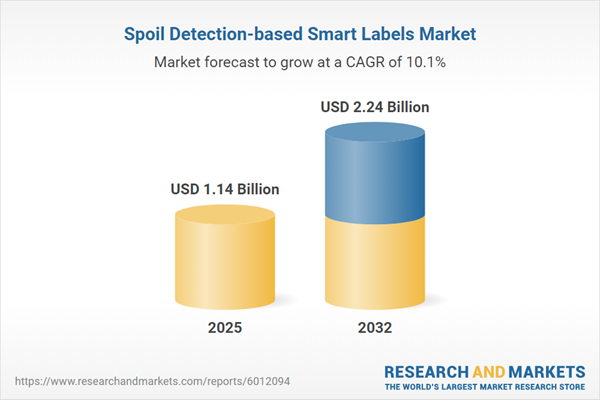Speak directly to the analyst to clarify any post sales queries you may have.
Spoil detection-based smart labels are redefining supply chain visibility for organizations managing perishables, offering real-time insights, efficient quality control, and compliance advantages. These advanced solutions are streamlining food, beverage, and pharmaceutical operations worldwide, equipping decision-makers to address evolving market and regulatory challenges.
Market Snapshot: Spoil Detection-Based Smart Labels
The spoil detection-based smart labels market is expanding as new regulations and traceability standards set higher benchmarks for transparency. Companies in manufacturing and logistics are increasingly adopting sensor-driven smart labels to address risks of spoilage, preserve product quality, and enhance traceability from production through distribution. Growing investment in sensor-enabled packaging technology is accelerating quality checks and supporting faster adaptation to dynamic market demands. These developments are prompting organizations to reassess quality, compliance, and operational models across global supply chains.
Scope & Segmentation of the Spoil Detection-Based Smart Labels Market
This report outlines the key segments and applications shaping the evolution of spoil detection-based smart labels, guiding data-driven investment and partnership strategies:
- Application Areas: Smart labels are being deployed across food segments such as bakery, confectionery, dairy, meat, produce, and seafood, and in beverage and pharmaceutical sectors. They enable real-time monitoring and facilitate compliance with safety regulations.
- Type of Sensors: Integration of freshness indicators, gas sensors, and time-temperature sensors supports monitoring and tracing of product status throughout distribution channels.
- Label Technologies: Adoption covers color-changing labels, electronic tags with printed or flexible electronics, QR codes, and wireless systems—NFC and RFID—for faster verification and improved traceability.
- Detection Methods: Solutions use chemical sensing such as gas chromatography and pH measurement, visual colorimetric and optical techniques, and digital techniques including fluorescence, NFC, and RFID to support compliance.
- Substrate Materials: Labels utilize metal foil, paper, plastic, and textile substrates, with choices balancing cost, sustainability, and durability across packaging use cases.
- Distribution Channels: Implementation spans B2B offline sales, online purchasing, and direct purchasing agreements, increasing sourcing flexibility and supply chain efficiency.
- Regional Coverage: Adoption is seen in the Americas, Europe, Middle East, Africa, and Asia-Pacific, covering markets such as the United States, Canada, Mexico, China, India, Japan, Australia, and Southeast Asia, shaped by regional regulatory frameworks and user preferences.
- Company Landscape: Key players—Avery Dennison Corporation, CCL Industries Inc., Thin Film Electronics ASA, NXP Semiconductors N.V., Carrier Global Corporation, Timestrip Limited, Insignia Technologies Limited, Wiliot, Inc., Identiv, Inc., and E Ink Holdings Inc.—are advancing sensor integration and customizing smart label offerings globally.
Key Takeaways: Strategic Advances in Spoil Detection-Based Smart Labels
- Integrating real-time sensing in packaging helps organizations improve inventory management and strengthens supply chain decision-making.
- Collaboration among sensor developers, electronics producers, and packaging suppliers enables rapid responses to regulatory shifts and evolving market needs.
- Combining chemical, optical, and digital detection in smart labels enhances operational reliability and supports specific compliance objectives across industries.
- Analytics derived from smart label data support advanced inventory control and bolster both risk management and loss prevention strategies.
- Industries with intensive regulatory requirements rely on smart labels to enhance proactive risk management and maintain product quality for items with short shelf lives.
- Vendors adapt their offerings regularly to address changing local standards and customer expectations, ensuring continued relevance in diverse regions.
Tariff Impact: Navigating Regulatory Complexity in Smart Label Components
Recent tariff changes in the United States have raised production costs for key components of smart labels, including specialty inks and radio frequency modules. Companies are managing these trends by intensifying supplier vetting, increasing local sourcing, and reassessing overseas partnerships in light of new restrictions. These actions are part of a larger shift toward resilient supply chains and consistent regulatory compliance in a changing international trade context.
Methodology & Data Sources
This market intelligence is grounded in interviews with supply chain engineers, regulatory experts, sensor specialists, and end-users. Insights are supplemented with validated technical literature and patent data, ensuring dependable guidance for executive decisions.
Why This Spoil Detection-Based Smart Labels Report Matters
- Delivers senior management timely insights on advancing technologies and regulations, supporting operational agility and compliance planning in the spoil detection-based smart labels sector.
- Presents clear segmentation and competitive intelligence, enabling leaders to identify and evaluate entry or expansion opportunities within the global market landscape.
- Strengthens supply chain transparency and resilience, facilitating risk management and more cost-effective compliance across critical segments.
Conclusion
Spoil detection-based smart labels are pivotal in driving supply chain transparency and operational intelligence, enabling organizations to remain responsive and compliant as industry requirements develop.
Additional Product Information:
- Purchase of this report includes 1 year online access with quarterly updates.
- This report can be updated on request. Please contact our Customer Experience team using the Ask a Question widget on our website.
Table of Contents
3. Executive Summary
4. Market Overview
7. Cumulative Impact of Artificial Intelligence 2025
Companies Mentioned
The companies profiled in this Spoil Detection-based Smart Labels market report include:- Avery Dennison Corporation
- CCL Industries Inc.
- Thin Film Electronics ASA
- NXP Semiconductors N.V.
- Carrier Global Corporation
- Timestrip Limited
- Insignia Technologies Limited
- Wiliot, Inc.
- Identiv, Inc.
- E Ink Holdings Inc.
Table Information
| Report Attribute | Details |
|---|---|
| No. of Pages | 198 |
| Published | November 2025 |
| Forecast Period | 2025 - 2032 |
| Estimated Market Value ( USD | $ 1.14 Billion |
| Forecasted Market Value ( USD | $ 2.24 Billion |
| Compound Annual Growth Rate | 10.1% |
| Regions Covered | Global |
| No. of Companies Mentioned | 11 |









